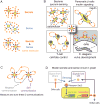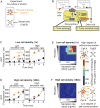Secreting and sensing the same molecule allows cells to achieve versatile social behaviors
- PMID: 24503857
- PMCID: PMC4145839
- DOI: 10.1126/science.1242782
Secreting and sensing the same molecule allows cells to achieve versatile social behaviors
Abstract
Cells that secrete and sense the same signaling molecule are ubiquitous. To uncover the functional capabilities of the core "secrete-and-sense" circuit motif shared by these cells, we engineered yeast to secrete and sense the mating pheromone. Perturbing each circuit element revealed parameters that control the degree to which the cell communicated with itself versus with its neighbors. This tunable interplay of self-communication and neighbor communication enables cells to span a diverse repertoire of cellular behaviors. These include a cell being asocial by responding only to itself and social through quorum sensing, and an isogenic population of cells splitting into social and asocial subpopulations. A mathematical model explained these behaviors. The versatility of the secrete-and-sense circuit motif may explain its recurrence across species.
Figures





Comment in
-
Cell biology. Cells listen to their inner voice.Science. 2014 Feb 7;343(6171):624-5. doi: 10.1126/science.1250244. Science. 2014. PMID: 24503846 No abstract available.
Similar articles
-
Cell biology. Cells listen to their inner voice.Science. 2014 Feb 7;343(6171):624-5. doi: 10.1126/science.1250244. Science. 2014. PMID: 24503846 No abstract available.
-
Ratiometric GPCR signaling enables directional sensing in yeast.PLoS Biol. 2019 Oct 17;17(10):e3000484. doi: 10.1371/journal.pbio.3000484. eCollection 2019 Oct. PLoS Biol. 2019. PMID: 31622333 Free PMC article.
-
Gβ promotes pheromone receptor polarization and yeast chemotropism by inhibiting receptor phosphorylation.Sci Signal. 2016 Apr 12;9(423):ra38. doi: 10.1126/scisignal.aad4376. Sci Signal. 2016. PMID: 27072657 Free PMC article.
-
Autocrine Signaling and Quorum Sensing: Extreme Ends of a Common Spectrum.Trends Cell Biol. 2016 Apr;26(4):262-271. doi: 10.1016/j.tcb.2015.11.002. Epub 2015 Dec 5. Trends Cell Biol. 2016. PMID: 26671200 Review.
-
A focus on yeast mating: From pheromone signaling to cell-cell fusion.Semin Cell Dev Biol. 2023 Jan 15;133:83-95. doi: 10.1016/j.semcdb.2022.02.003. Epub 2022 Feb 9. Semin Cell Dev Biol. 2023. PMID: 35148940 Review.
Cited by
-
Light-Activated Signaling in DNA-Encoded Sender-Receiver Architectures.ACS Nano. 2020 Nov 24;14(11):15992-16002. doi: 10.1021/acsnano.0c07537. Epub 2020 Oct 20. ACS Nano. 2020. PMID: 33078948 Free PMC article.
-
Gamete signalling underlies the evolution of mating types and their number.Philos Trans R Soc Lond B Biol Sci. 2016 Oct 19;371(1706):20150531. doi: 10.1098/rstb.2015.0531. Philos Trans R Soc Lond B Biol Sci. 2016. PMID: 27619695 Free PMC article.
-
Modular, robust, and extendible multicellular circuit design in yeast.Elife. 2022 Mar 21;11:e74540. doi: 10.7554/eLife.74540. Elife. 2022. PMID: 35312478 Free PMC article.
-
Yeast mating and image-based quantification of spatial pattern formation.PLoS Comput Biol. 2014 Jun 26;10(6):e1003690. doi: 10.1371/journal.pcbi.1003690. eCollection 2014 Jun. PLoS Comput Biol. 2014. PMID: 24967739 Free PMC article.
-
Build to understand: synthetic approaches to biology.Integr Biol (Camb). 2016 Apr 18;8(4):394-408. doi: 10.1039/c5ib00252d. Epub 2015 Dec 21. Integr Biol (Camb). 2016. PMID: 26686885 Free PMC article. Review.
References
Publication types
MeSH terms
Substances
Grants and funding
LinkOut - more resources
Full Text Sources
Other Literature Sources
Molecular Biology Databases

